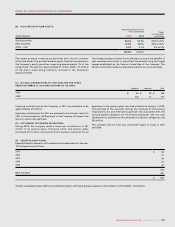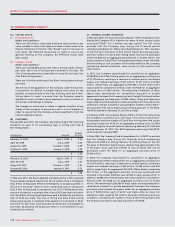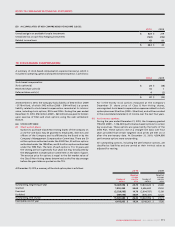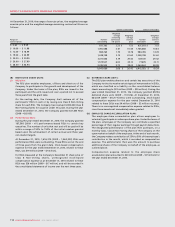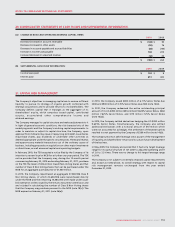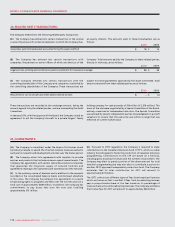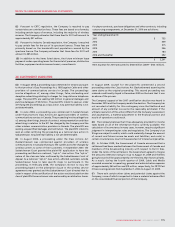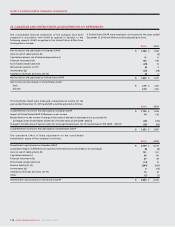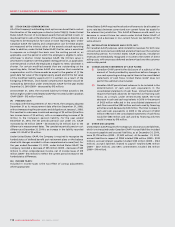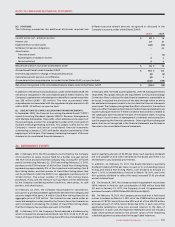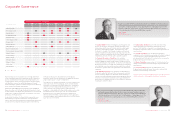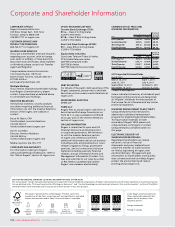Rogers 2010 Annual Report Download - page 114
Download and view the complete annual report
Please find page 114 of the 2010 Rogers annual report below. You can navigate through the pages in the report by either clicking on the pages listed below, or by using the keyword search tool below to find specific information within the annual report.
NOTES TO CONSOLIDATED FINANCIAL STATEMENTS
118 ROGERS COMMUNICATIONS INC. 2010 ANNUAL REPORT
(E) STOCK-BASED COMPENSATION:
All of the Company’s outstanding stock options can be settled in cash at
the discretion of the employee or director (note 19(a)(i)). Under United
States GAAP, the cost of stock-based awards that are settled in cash, or
may be settled in cash at the discretion of the employee or director, are
required to be measured at fair value on each reporting date. Under
Canadian GAAP, the liability and compensation cost for these awards
are measured at the intrinsic value of the awards at each reporting
date. In addition, under United States GAAP, the fair value is amortized
to expense on a straight-line basis over the vesting period or, as
applicable, over the period in which the employee is eligible to retire,
whichever is shorter. Under Canadian GAAP, the intrinsic value is
amortized to expense over the graded vesting period or, as applicable,
over the period in which the employee is eligible to retire, whichever is
shorter. For certain modified awards that are outstanding at the
reporting date, United States GAAP also requires that cumulative
compensation cost for these awards be equal to the greater of (i) the
grant-date fair value of the original equity award and (ii) the fair value
of the modified liability award until it is settled. As a result of the
foregoing differences, stock-based compensation expense would be
increased by $29 million under United States GAAP for the year ended
December 31, 2010 (2009 – decreased by $13 million).
At December 31, 2010, the recorded liability for these awards is $14
million higher under United States GAAP than recorded under Canadian
GAAP (2009 – $13 million lower).
(F) PENSION COST:
To comply with the requirements of ASC 715-20, the Company adopted
December 31 as its measurement date effective December 31, 2008,
without remeasuring the plan assets and obligations at January 1, 2008.
This resulted in a decrease in retained earnings of $4 million ($6 million
less income taxes of $2 million), with a corresponding increase of $6
million to the Company’s pension liability. For the year ended
December 31, 2010, the net periodic pension cost under U.S. GAAP
increased by $5 million (2009 – decreased by $3 million) due to the
difference in measurement dates. The cumulative periodic pension cost
difference at December 31, 2010 is an increase in the liability recorded
under U.S. GAAP of $2 million.
Under United States GAAP, the Company is required to recognize the
funded status of defined benefit post-retirement plans on the balance
sheet with changes recorded in other comprehensive income (loss). For
the year ended December 31, 2010, under United States GAAP, the
Company recorded a decrease of $55 million (2009 – decrease of $45
million) to other comprehensive income, net of income taxes of $19
million (2009 – $16 million) to reflect the current period increase in the
funded status differences.
(G) INCOME TAXES:
Included in income taxes is the tax effect of various adjustments
where appropriate.
United States GAAP requires the valuation allowance to be allocated on
a pro rata basis between current and non-current future tax assets for
the relevant tax jurisdiction. This GAAP difference would result in a
decrease in current future tax assets under United States GAAP of
$2million and a decrease in non-current future tax liabilities of the
same amount.
(H) INSTALLATION REVENUES AND COSTS, NET:
For Canadian GAAP purposes, cable installation revenues for both new
connects and reconnects are deferred and amortized over the customer
relationship period. For United States GAAP purposes, installation
revenues are immediately recognized in income to the extent of direct
selling costs, with any excess deferred and amortized over the customer
relationship period.
(I) CONSOLIDATED STATEMENTS OF CASH FLOWS:
(i) Canadian GAAP permits the disclosure of a subtotal of the
amount of funds provided by operations before changes in
non-cash operating working capital items in the consolidated
statements of cash flows. United States GAAP does not
permit this subtotal to be included.
(ii) Canadian GAAP permits bank advances to be included in the
determination of cash and cash equivalents in the
consolidated statements of cash flows. United States GAAP
requires that bank advances be reported as financing cash
flows. As a result, under United States GAAP, the total
decrease in cash and cash equivalents in 2010 in the amount
of $423 million reflected in the consolidated statements of
cash flows would be $383 million and cash used by financing
activities would decrease by $40 million. The total increase in
cash and cash equivalents in 2009 in the amount of $402
million reflected in the consolidated statements of cash flows
would be $383 million and cash used by financing activities
would increase by $19 million.
(J) OTHER DISCLOSURES:
United States GAAP requires the Company to disclose accrued liabilities,
which is not required under Canadian GAAP. Accrued liabilities included
in accounts payable and accrued liabilities, as at December31,2010,
were $2,178 million (2009 – $1,843 million). At December 31,2010,
accrued liabilities in respect of PP&E totalled $196 million (2009 – $108
million), accrued interest payable totalled $155 million (2009 – $144
million), accrued liabilities related to payroll totalled $294 million
(2009 – $337 million), and CRTC commitments totalled $14 million
(2009 – $10 million).



